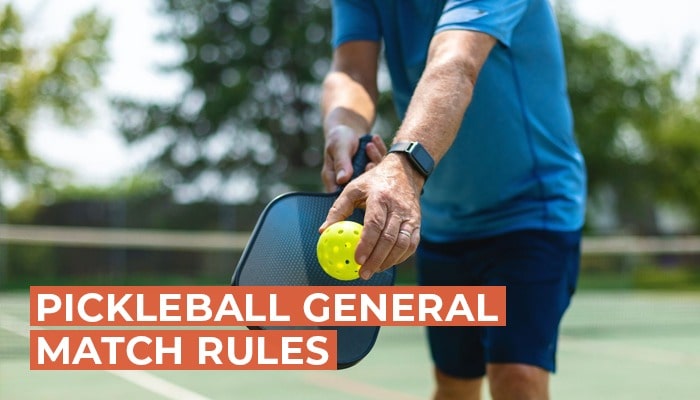The Pickleball Match consists of a set of 3 matches. The team that leads with 2 matches will win the game. It is usually played for eleven points and if there is a high-level tournament consisting of one match then that is played for fifteen points. The Pickleball matches can be played as both doubles or singles depending upon the situation. Singles and doubles are played keeping similar guidelines with marginally unique scoring techniques.
The Serve:
In a Pickleball game, the principal serve is considered to be done by the player standing on the right side of the playing field. The play begins with the serve. Before serving the server should call the score.
A Pickleball serve should be hit from behind the baseline crosscourt into the rival group’s administrative court. The serve should not bounce in the kitchen. Sometimes it happens that the ball will hit the net yet at the same time land in the right serving court. In pickleball, this is termed as a let and the server should keep on trying the serve until he serves correctly or unless he hits the ball into the net, or hits the ball out of the designated region.
Assuming the ball hits the net and grounds in the kitchen, it is counted as a fault. It is also a fault if the serve hits the net and does not cross over to the other side of the court or if the serve directly lands outside the opponent’s court area.
The Principle of Two Bounce Rule:
It is a must for the ball to bounce two times around the court immediately before the players hit the ball on the ‘volley’ or in the air. So when the player serves the ball it must bounce in the opponent’s court before the opponent can play and once the opponent hits it back (after the bounce) the server must also wait for the ball to bounce before he can hit it back. This practice is done only at the time of the serve. Afterward, each player can hit the ball before it has bounced, implying the ball can be hit in the air. New players frequently fail to remember this and begin to climb rapidly with the serve and get found hitting the ball in the air before the two-bounce rule has been completed.
The Return of Serve:
The player returning the serve should allow the ball to bounce before returning it to the rival group’s side in either administration court. We have already discussed this above.
The Rule of Non-Volley Zone Faults/ Kitchen rules:
The area of the Non-Volley Zone is 7 x 20 feet which are rectangular in shape. The area of this game is so wide that it is easier for the player to stay back from the net when hitting the ball in the air. Hence, it eliminates the risk of injury to a rival player.
Here are some rules you need to keep in mind with respect to the non-volley zone.
- You can not volley the ball in the air while standing in the non-volley zone.
- You can not volley the ball in the air and then step in the non-volley zone while steadying yourself from that particular shot.
- If you are volleying the ball in the air, your feet should be behind the line of the non-volley zone during the shot and afterward, while you steady yourself. Once you are steady (it only takes a moment to steady yourself), you may step into the non-volley zone.
- You can however volley the ball inside the non-volley zone if the ball has already bounced.
This is perhaps the most troublesome principle for players to adjust to, especially those playing tennis or watching it. You are also not allowed to drop your accessories in the kitchen zone. Your cap or oar falling in is viewed as an issue.

Flaws:
In Pickleball mishandling of balls is called flaw. There are a few significant faults that can be made in a game.
Twofold Bounce Rule: Hitting a volley before the ball has bounced once at the start of the game during the serve.
The ball has to bounce at least once on each side of the court before it can be hit. On the off chance that the ball bounces at least a few times, it is a shortcoming.
Hitting the ball beyond the field of play is a fault. Where the portion of the ball contacts the ground decides if a ball is inside or outside the line of the court.
Assuming the ball is hit into the net and does not cross over to the other side of the court, it is considered a fault.
If a player plays the ball in the air (volley) while standing in the kitchen is a fault. It is also a fault if the player steps into the kitchen area while balancing himself after he has played the ball in the air (volley). It is also a fault if the player does not step into the kitchen after playing the volley but is standing just outside of the kitchen and finding it hard to balance himself and not tip over inside the kitchen. In this last particular case, the player has not stepped in the kitchen but he is also not balanced after the volley and is hardly able to stand just outside the line of the kitchen.
How to play pickleball on the tennis net:
In case you only have access to a tennis court and you want to play pickleball on it then several options are available for you. Which one is best will depend upon how long-lasting changes you will make. Following are the conditions depending upon which you can play.
Using the net of tennis:
The net of the Tennis game is placed higher than the net of pickleball. But this problem can be resolved easily. You can easily convert a tennis net to a pickleball net by bringing it down a couple of inches. With the help of the adjuster, you need to set the net from the center to thirty-four inches and from the side to thirty-six inches. One of the most concerning factors of playing pickleball on a court of tennis is the difference of lines since this is the most tricky element as compared to others. If not done appropriately, it can cause disarray for both tennis and pickleball players.
As we would see it, the best methodology is to separate the lines for the two games by shading. You can easily manage it by drawing the lines brighter or lightening them somewhat. Simply ensure lighter shades are far from white so that they can’t be mistaken for the tennis court lines.
You have two options available to get this done. Either use tape or use paint. Tape is somewhat temporary therefore I recommend it only if you are not certain you would continue playing the game, or in case you are not very regular. In case you are certain you wish to play regularly and often then I would suggest going for the paint to draw the lines.
Rules of Three-Player Pickleball:
The first rule of the three-player pickleball is that two of the players would be on one end of the pickleball field and one player would be on the other side.
• Each of the teams will get a chance to serve a ball.
• Two serve points will be given to each serve.
• The server will serve from the right-hand administration line when the score is even.
Step-by-step instructions to improve at pickleball:
I recommend three explicit activities that can assist with improving your pickleball execution.
- Do some skipping:
The primary test of pickleball isn’t hitting the ball, as that is somewhat simple. It’s getting to the ball; particularly when your adversaries are attempting to hit it away from you. - Hit a ball against a divider:
Another activity that can assist with further developing your game just requires a divider and your pickleball oar. - Work on your judgment abilities:
Something that can truly assist you with increasing your game is becoming aware of when to leave balls that you foresee falling outside of the playing area of the court. This means rather than hitting it back, let the ball pass by you if you feel it is not going to bounce in the playing area of the court. You should anticipate where the ball will land and shout ‘out’ or ‘in. This is a decent method for preparing your judgment abilities so you realize which balls to hit back and when to secure a free point.
How to play pickleball at home:
There are four important elements you need to have before playing pickleball at home:
- Space
- Net
- Instruments for marking lines
- Pickleball or oars


Comments are closed.